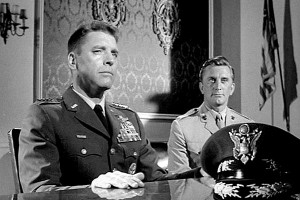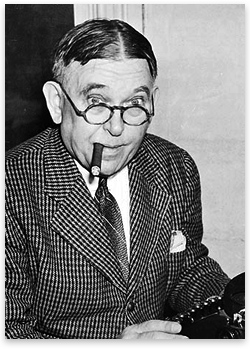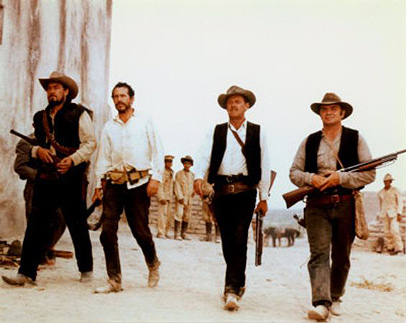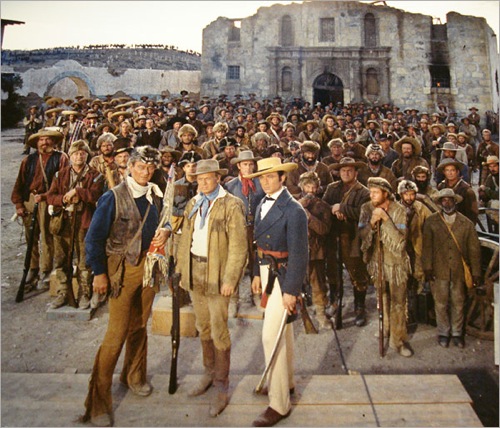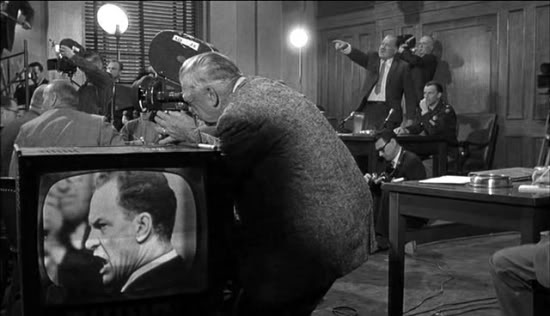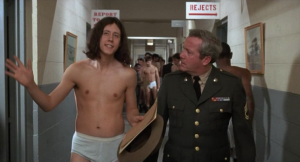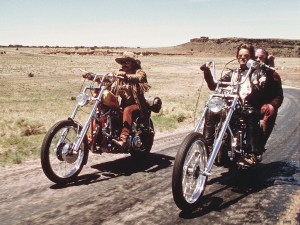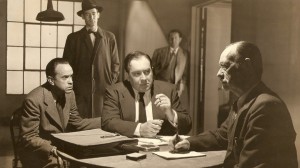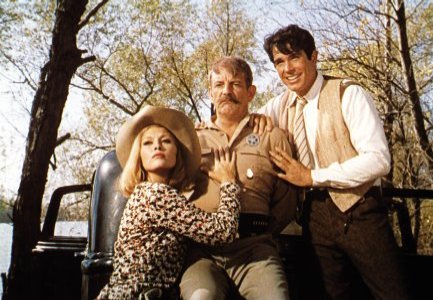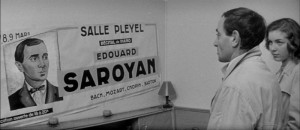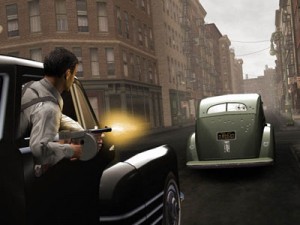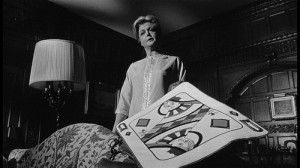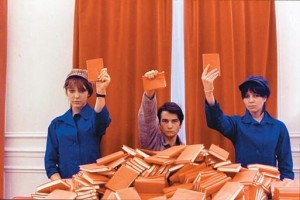From Cinema Scope no. 17 (Winter 2003); reprinted in Goodbye Cinema, Hello Cinephilia. — J.R.
The Dream Life: Movies, Media, and the Mythology of the Sixties
by J. Hoberman (New York/London: The New Press, 461 pp., 2003.
“You know, I’m not someone who ever survived the Depression,” the great American film critic and painter Manny Farber once said to me, back in the late 1970s. “It’s not the sort of experience you ever really get over.” This was in part a gentle rebuke to someone born after the 1930s who tended to romanticize that era —- seeing glimmers of communal warmth and common cause leaking through all that picturesque poverty, especially in Hollywood pictures. For me, the 1930s were a legendary period —- the time in the U.S. when socialism came closest to being a mainstream position. Indeed, the next two decades in American history might be viewed as a series of desperate holding actions against the dreams nurtured in that epoch.
By contrast, the 1960s was a period of prosperity that nurtured outsized utopian dreams of its own —- dreams so grandiose that the succeeding decades up to the present could be viewed as another set of fearful responses. Having spent part of my teens and all of my twenties during the countercultural uprisings, I’m not sure I can say with confidence that I ever fully survived that period myself. But for J. Hoberman, six years younger than me, one feels it was more a pivotal than a terminal stage in his education — making him unusually well suited to chart its developing mythologies and unpack its excesses, because he’s no longer living there.
Working this time as neither a film scholar nor a film critic -— roles he has taken on with distinction in such previous books as his definitive history of Yiddish cinema (Bridge of Light) and his no less authoritative On Jack Smith’s Flaming Creatures (and Other Secret-Flix of Cinemaroc), as well as his two critical collections (Vulgar Modernism and The Magic Hour, designed successively as chronicles of the 1980s and 1990s) —- Hoberman veers closer to the kind of social and ideological history he broached in The Red Atlantis: Communist Culture in the Absence of Communism, although this time with a more specific narrative line. Usefully defining the American Sixties as a fifteen-year “decade” stretching from the launch of Sputnik in 1957 to “the media-driven debacle known as Watergate” in 1972, he offers a provocative demystification that is also, curiously enough, a wry celebration of that era’s dream life as reflected as well as informed by commercial movies.
Over the course of three successive U.S. Presidents and four elections, with Vietnam hovering in the background as a constant, anxious undertow, Hoberman tracks the emergence of a bewildering and generally obfuscating trend in public life —- the interfacing of media and politics: “Given the post-1960 tele-saturation of the American marketplace, the corresponding development of political image-building and the advent of a self-conscious Pop Art, as well as the relaxation of long-standing codes that governed the protocols of mass-media content, the distinction between passive consumer and active participant blurred. Movies might be political events, and political events were experienced as movies.”
After establishing in his Introduction that “there was a sense” during this period “that electoral politics, the mass media, and publicity had combined in a new totality —- an additional atmosphere, a second nature, the dream life of the nation,” Hoberman proceeds to chart the manifestations of this “new totality” chronologically over half a dozen chapters, forging a rich tapestry in which high-profile film releases and diverse social, cultural, and political events become increasingly interchangeable as expressions of the same collective mythology. Thus the 1964 military-coup scare thriller Seven Days in May is examined from its origins in a best seller the previous year (juxtaposed with both the Cuban Missile Crisis and Andy Warhol’s first one-man show in New York) to its release after the Kennedy assassination in Dallas, with disquieting production information along the way. (“The opening scene of right-wing pickets scuffling with Ban-the-Bombers outside the White House was shot a few days after the 1963 Nuclear Test Ban Treaty was initialed in Moscow, and according to Variety, actual anti-test Ban demonstrators had to be dispersed to facilitate the staged disturbance.”)
***
As an intellectual journalist, Hoberman has many traditions to draw upon, but two in particular stand out: the more detached (albeit pessimistic and unforgiving) cultural analysis practiced by the FrankfortSchool and the more genial, humorous, and appreciative style associated with American muckraking. The first of these functions as a kind of adult conscience, the second as a kind of lively sport. But it would be inexact to say that Hoberman generally chooses between these separate traditions or seeks to employ them dialectically, as alternative strategies. More often, he seems to work with them in tandem, and a good deal of the ambiguous flavor of this book derives from the various ways he combines the rigors of an analyst with some of the instincts of a spoiler.
To address the issue somewhat differently, and more concretely, is it possible to reconcile the separate agendas of Siegfried Kracauer (1889-1966, cited in the book’s second sentence) and H.L. Mencken (1880-1956, not cited at all)? I’m not sure it is, despite their common Germanic roots and the fact that they were only a decade apart from being precise contemporaries. But it has to be conceded that Hoberman comes closer than anyone else I can think of to performing this impossible shotgun marriage — with a giddy kind of verve driving his most scathing prose. Here are a few treasures among many:
[Kracauer]
Freedomland is consecrated to the Hegelian notion
that history is rational and that the history of the
world has achieved full consciousness —- in the existence
of the United States. The past is petrified, and so is
the future. The present is somewhat less certain.
[Mencken]
Three weeks after [Barry] Goldwater was nominated,
[Lyndon] Johnson demonstrated total control over
the Democratic convention held in Atlantic City —- a
tawdry town of ancient fan-dancers and geriatric
flagpole-sitters where, in addition to kewpie dolls
and saltwater taffy, the boardwalk’s souvenir stands
hawked plastic wall hangings inscribed with JFK’s
imagined beyond-the-grave message to his wife.
[Kracauer/Mencken]:
Had there ever been an American Western in
which humanity was so consistently venal,
cowardly, and cruel as in The Wild Bunch? The law
is represented by the railroad company; its agents
are moronic bounty hunters riding behind the
unwilling ex-convict Deke Thornton (RobertRyan).
The Bunch are less like [John] Wayne’s Green Berets
than the Commanches that Wayne battled in The
Searchers; they kill their own wounded and leave
them unburied. Western morality is obliterated. In
this scenario, there are no good guys. A postscript
shows Thornton recruited to the Mexican revolution,
but this faint echo of Magnificent Seven idealism
glosses The Wild Bunch’s real pleasures —- the thrill
of invasion and massacre of foreigners.
America was involved in the most elaborate
military operation since World War II, except that
only a small percentage of society seemed directly
affected. There was no food rationing, no gas
coupons, no Liberty Bonds, no real home front. Dirty
Harry’s belligerent invocation of martyred police —- a
prophecy, in its list of names, of the eventual
Washington, DC, Vietnam Memorial -— proposed cops as our
foot soldiers. (Dirty Harry’s concern for the war at
home is reinforced by those images, then unique, of
choppers hovering over San Francisco, as if the city
itself were a free fire zone —- which is what it turns
out to be.)
One of the teasing ambiguities arising from this sort of blend is the question of agency: is Sam Peckinpah, the auteur of The Wild Bunch, exhibiting American xenophobia, criticizing it, or some of both? And what about DonSiegel, the supposedly (or at least usually) liberal auteur of Dirty Harry? Not that Hoberman necessarily needs to resolve these questions. But the degree to which the fantasies are driving the films rather than vice versa is a matter he most often prefers to broach and then leave unsettled —- understandably, because intentionality is generally a hornet’s nest. After all, we can probably safely say that The Searchers is both objectively racist and one of the most insightful depictions of racism found in American cinema. Choosing between those descriptions might ultimately mean short-changing the film’s impact and importance, and ascribing either or both attributes to John Ford only complicates matters further. (Even so, Hoberman is not above offering critical annotations when they serve his argument —- as in his hilariously apt thumbnail description of The Man Who Shot Liberty Valance as “Ford’s going-out-of-business sale”.)
On the other hand, when Hoberman suggestively juxtaposes Spartacus with The Alamo as an articulation of the 1960 presidential campaign in which Kennedy opposed Goldwater — ticking off the veiled references to the Hollywood blacklist in the first film’s dialogue, written by formerly blacklisted Dalton Trumbo — he’s letting a few intentions creep into the picture. And this raises the question of how legible such subtexts might have been at the time: surely more evident than similarly veiled references to the blacklist were in The Robe, scripted without credit by the blacklisted Albert Maltz in 1953, but still probably more meaningful today than they were in 1960.
The critical part of my nature flinches a little when Hoberman, after noting that JFK essentially green-lighted the production of The ManchurianCandidate, goes on to call it “a bit Bondlike in its futuristic technology, robotic hit men, sinister Asians, and joking violence” —- as if Ian Fleming and satirist George Axelrod were really brothers under the skin. But then he goes on to concede that “Once the spectator realizes that the Cold War is the nightmare from which the hero FrankSinatra is trying to awake,” the film “is genuinely self-reflexive.” And it’s certainly legitimate to conclude that the film is also one of the “Kennedy scenarios” (along with Advise and Consent, Seven Days in May, Dr.Strangelove, and Fail-Safe) that “conceived American democracy as the province of demagogues, extortionists, traitors, megalomaniacs, and assassins.” Even if JFK didn’t write those scripts, his carefully manufactured image presided over their executions.
***
On his cooler Kracauer side, Hoberman does a brilliant job of analyzing the social fantasies of both the right and left during this period as if they were all a string of overblown movies, or finding diverse other ways of interrelating films and public events — as politicians and filmmakers were themselves often doing then. (A particular favorite: “LBJ’s entire Vietnam visit lasts two hours and twenty-four minutes —- only three minutes longer than the eventual running time of The Green Berets.”) In this respect, his enterprise recalls at times the methods of Hans-JürgenSyberberg in Hitler, A Film from Germany. Some of the early portions of his own juicy narrative could in fact be called JFK, A Film from the U.S. if it weren’t for the fact that the U.S. becomes the designated recipient as well as the deliverer of this national message. This is more or less where Mencken steps in. As a muckraking satirist who took a great deal of pleasure in celebrating the American excesses that he skewered for the benefit of his compatriots —- characteristically attaching flyers for hog-calling contests and the like to the letters he sent to friends —- Mencken was something of a grandstander as well as an analyst, and this becomes part of Hoberman’s style as well; those plastic wall hangings are partially there to be perversely enjoyed, not simply noted.
In fact, a good deal of The Dream Life unfolds like a Menckenesque scrapbook of American folly and hyperbole fed by the more hysterical social myths of the period coming from the left as well as the right, the freaks as well as the straights. Thus Alice’s Restaurant is viewed with the same sort of skepticism as Easy Rider; while “both movies articulate a general sense of failure” in American culture, they’re also “equally devoid of political analysis and deep in political denial.” More comically, on the left we find Twentieth Century-Fox chairman Darryl F. Zanuck, after gleaning from a survey in Fortune magazine that Che Guevara was more popular on college campuses than LBJ, Nixon, Hubert Humphrey, or George Wallace, rushing to the Cote d’Azur with director Richard Fleischer in order to wrest Omar Sharif away from a bridge tournament so he can be cast as the revolutionary superstar in a blockbuster biopic — which Sharif reluctantly submits to only if a special “conscience clause” is written into his contract. After a production budget “bigger than Castro’s” (“It costs more to make a movie about a revolution than it does to make a revolution,” reports JohnLeonard in the New York Times, calculating the cost at “about $10,000 an hour”), the movie finally opens disastrously in the spring of 1969 to empty theaters.
And on the right? Apart from the various statements and personal projects of JohnWayne, a key player and reliable buffoon in these pages, we learn that the “Reverend [DavidA.] Noebel, a preacher with the Christian Anti-Communist Crusade, had revealed `a systematic plan geared to making a generation of American youth mentally ill and emotionally unstable’ in his 1965 pamphlet, Communism, Hypnotism and the Beatles.”
Beyond the parameters of left and right, one finds the overweening self-importance of the period’s commentators. During the summer when Apollo XI, the manned rocket to the moon, was launched, and a third of a million freaks turned up at the music festival in Woodstock, Hoberman reports that “The New York Times editorialists were sufficiently delirious to imagine the last half of July 1969 `the most revolutionary and significant fortnight of the entire twentieth century.’ Covering the Apollo launch for Life, [Norman] Mailer scarcely hesitated in calling the moon mission `the climax of the greatest week since Christ was born.’”
It makes for lively reading, yet there are times when celebratory skeet-shooting of this kind can interfere with analysis or a precise sense of history, especially when parts of it sound almost too good to be true. Though there are some unadorned facts in this study that leap out of the page, and deserve to be better known —- we learn that “The Pentagon eventually revealed that a third of all enlistees [during the war in Vietnam] had tried heroin, with nearly two-thirds of those developing a habit” —- the bulk of the survey is devoted to media representations, and it suits Hoberman’s purpose that a disproportionate number of them are over-the-top extravaganzas of one kind or another. It’s hard to resist alluding to The Woman on Pier 13 only by its prerelease label, I Married a Communist (used by producer HowardHughes to “test” the political credentials of the Hollywood directors he offered it to), even if no one ever actually saw a movie with that title. Or to resist converting a peevish and jokey aside of Nikita Khrushchev on a New York TV talk show, “We will bury you” into an ominous “[threat] to bury capitalism,” much as American media mavens were doing at the time. You might say it makes good copy, but insofar as it does, this is a loophole that Hoberman shares with some of his targets.
And there are other times when restricting the mad American spectacle to American spectators on their native soil needlessly limits the focus. This is a drawback I’m especially keen to because during the latter parts of the book’s chronology I was living in France, where certain aspects of The Dream Life were thrown into even bolder relief. When I attended the world premiere of Woodstock in Cannes in 1970, director Michael Wadleigh, a hippie himself, dramatically dedicated this Hollywood release to the students just killed at KentState and solemnly passed out black armbands after the screening. Within days, black armbands were selling briskly in the local boutiques, implicitly serving as plugs for Warner Brothers —- a prime instance of how quickly a gesture of political solidarity could instantly become part of someone else’s promotional campaign when one wasn’t looking.
On the other hand, I luckily missed much of the feeding frenzy in the alternative press occasioned by the grotesque countercultural celebration of the bloody exploits of Charles Manson and his extended “family,” which Hoberman chronicles in depressing detail, and which might well have tarnished some of my radical idealism if I’d still been around for it. This was only one of the sour turns taken by the radical left in the early 1970s — though Hoberman suggests it may have been largely the establishment that encouraged the immediate identification of the counterculture with mass murder: “While Los Angeles district attorney Vincent Bugliosi complained that Manson had become a `cause,’ the Berkeley Barb noted that prison authorities fostered Manson’s countercultural image, permitting the monster to keep his long hair, bellbottoms, and fringe leather shirts, repeatedly presenting him to be photographed in full hippie regalia.”
As with so much of the evidence in the book, the media mechanisms set in motion by the fearful fever-dreams of the right —- mechanisms by which the most graphic fantasies of the left were blatantly encouraged and even advertised so that they might then overtake and ultimately supplant the political discourse underlying them — turned practically every rebellious blade-thrust into a two-edged sword, a frontal attack that became a form of self-immolation. (According to the recent research of American independent filmmaker Jay Craven for his feature The Year That Trembled, there is some reason to suspect that the burning of an ROTC building at KentState that sparked the shooting of students may have actually been done by an FBI agent provocateur posing as a radical.)
***
For all his all-American appreciation of yahoo excess, Hoberman, unlike Mencken, doesn’t hail from Baltimore. Although The Dream Life isn’t obvious about this, a New Yorker’s view of American culture subtly inflects its view of the zeitgeist, especially when it comes to the vantage point of its own research. Bosley Crowther, for instance -— the stuffy New York Times reviewer who figured as a favorite bête noir of local film buffs —- is possibly accorded more significance as a mainstream commentator on commercial movies than he would have likely had outside Manhattan and Hollywood.
Pauline Kael, who deservedly receives still more attention, is inexactly described as a `Berkeley-based freelancer’ when she published her famous 9,000-word defense of Bonnie and Clyde in The New Yorker in 1967, the same year that Crowther retired — and two years after she moved to New York. More importantly, Hoberman is attentive to the impact this essay had both in establishing Kael at The New Yorker and in ratifying the cultural credentials of Bonnie and Clyde. But one could expand on this notion and posit Kael’s manifesto as a turning point in American film criticism as well as American filmmaking that veered it away from the relative internationalism then being spearheaded by Andrew Sarris, her arch rival at the time, and towards a more home-grown patriotism that also implied a certain isolationism. Bonnie and Clyde was itself pivotal in this respect, because its script by Robert Benton and David Newman was inspired by the unstable genre mixes of the French New Wave and in fact had been offered to François Truffaut and Jean-Luc Godard to direct at separate junctures before the assignment went to native son Arthur Penn. What made Kael’s defense of the film partisan in a nationalistic way was her differentiation between Americans and `the French’. Consider the following paragraph:
If this way of holding more than one attitude toward life is already familiar to us -— if we recognize the make-believe robbers whose toy guns produce real blood, and the Keystone cops who shoot them dead, from Truffaut’s Shoot the Piano Player and Godard’s gangster pictures, Breathless and Band of Outsiders -— it’s because the young French directors discovered the poetry of crime in American life (from our movies) and showed the Americans how to put it on the screen in a new, “existential” way. Melodramas and gangster movies and comedies were always more our speed than “prestigious,” “distinguished” pictures; the French directors who grew up on American pictures found poetry in our fast action, laconic speech, plain gestures. And because they understood that you don’t express your love of life by denying the comedy or the horror of it, they brought out the poetry in our tawdry subjects. Now Arthur Penn, working with a script heavily influenced -— one might almost say inspired -— by Truffaut’s Shoot the Piano Player, unfortunately imitates Truffaut’s artistry instead of going back to its tough American sources. The French may tenderize their American material, but we shouldn’t. That turns into another way of making “prestigious,” “distinguished” pictures.
One could argue that the most ideologically pertinent words in this polemic are all first-person plural pronouns: “us” and “our” in the first sentence, “our” (used twice) in the second, and “we” in the fifth. All imply a fundamental cleavage between French and American sensibilities, and what could be called French and American property in terms of both life and history, including film history. (One might even conclude from the syntax that French crime isn’t a tawdry subject until —- or unless —- it becomes Americanized.) Thus both French cinephiles who might have regarded certain American crime pictures as “our movies” -— not necessarily to the exclusion of Americans, but in concert with them -— and Americans who might have felt the same way about certain New Wave pictures become excluded from Kael’s line of reasoning; the very notion of a shared tradition is deemed inadmissible by definition. In more ways than one, the xenophobic underpinnings of Cold War rhetoric are faintly echoed in this discourse, and such strains were to become more rather than less pronounced -— and not only in Kael’s prose -— in the years to come.
Furthermore, once it became established that Americans could make their own art films -— Kael favorites like the first two Godfather pictures come to mind —- the very notion that they might learn something from foreigners got swept under the rug, with an audible sigh of relief.
Hoberman, who knows better than to use personal pronouns the way Kael does, can’t be accused of replicating any part of this discourse. Yet there are times when one wonders if he’s still become the unwitting beneficiary of some of its assumptions, if only through the way he intermittently treats The Dream Life as a kind of master text bound on either side by the Atlantic and the Pacific. This assumption is by no means monolithic —- which is why he can implicitly link the mythologies of Ian Fleming and George Axelrod without blinking, and, in spite of my own flinches, with some justice. (Indeed, the “urbanity” of both writers might be said to be routed through the fantasies of Playboy as well as the scenarios of JFK.) But he does tend to sidestep the degree to which many facets of American and European myths overlapped and interfaced in the 1960s.
I’m thinking, for instance, about how the week-long run of Godard’s film about Maoist students, La chinoise, at New York’s Kips Bay Theater in early April 1968, preceded the student takeover of Columbia University campus buildings by only a couple of weeks, and how the student uprisings in France in May 1968 were less than two weeks after that. What I’m stipulating aren’t simple chain reactions —- even if I had radical friends at Columbia who saw the Godard film more than once, and radical friends in Paris who were inspired in part by the events at Columbia. What I’m thinking about, rather, are the crosscurrents that made those two cities a lot closer to one another in shared aspirations and, yes, mythologies than many younger people, including possibly Hoberman, are apt to assume today.
Even though it’s hard to imagine a serious student radical at the Sorbonne expressing “hallucinated solidarity with the Manson Family,” as Hoberman shockingly reports Weather and former SDS activist Bernadine Dohrn doing (“Dig it: first they killed those pigs, then they ate dinner in the same room with them, then they even shoved a fork into the victim’s stomach. Wild!”) —- in part because widespread use of hallucinogens never took hold in Paris they way it did in New York or London — the more utopian fantasies of the period might be said to have galvanized Paris Maoists and Berkeley anarchists (as well as London squatters) with common and interlinking passions. I can even recall attending a comically confused mass meeting at the Sorbonne in 1969 or 1970 presided over by Jerry Rubin with a French translator —- though if any comparable rallies occurred on U.S. campuses at the time, these would have likely been grouped around Jean-Luc Godard and Jean-Pierre Gorin, not Daniel Cohn-Bendit.
For most of this review I’ve been expressing demurrals, yet it’s central to the strengths of The Dream Life that it provokes dialogue and counter-arguments rather than simple acquiescence. The sardonic cast of the prose guarantees that nostalgia for the 1960s is kept perpetually at bay —- to the consternation of aging hippies and the enlightenment of everyone else, including younger reformists who’ve grown understandably weary of their elders’ stale reveries. It’s a nostalgia that nowadays is just as apt to rhapsodize about how great the movies were than how great the sex, drugs, rock-and-roll, and demonstrations could be, and to mix metaphors, the bracing wet blanket that Hoberman tosses on these manifold delights functions as a useful and even timely wakeup call. He’s not out to spoil our fun but to help us understand it better, delusions and all.



